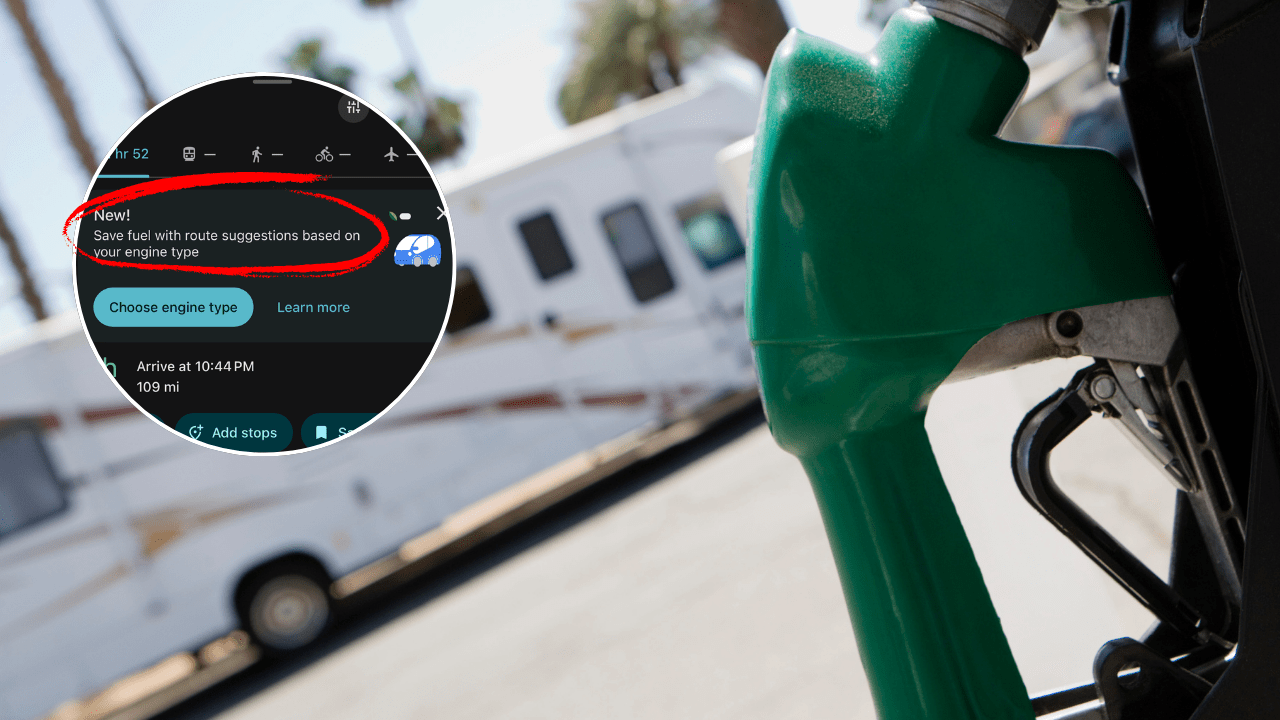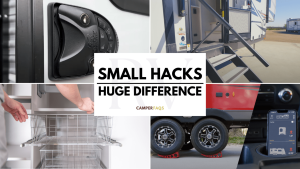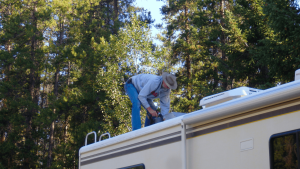Gas prices aren’t just high, they’re unpredictable. And when you’re driving (or pulling) a large box on wheels, every fill-up can feel like a punch to the wallet.
The good news? There are real, practical ways to cut your fuel costs without sacrificing the travel experience.
Before you hit the road again, read through these fuel-saving hacks and utilize as many as you can to maximize your savings!
1. Slow Down
One of the most effective ways to reduce fuel consumption, which is fully within your control, is to slow down.
Driving an RV at 55 to 60 miles per hour instead of 65 or 70 can noticeably reduce fuel consumption. Once you go faster, wind resistance increases, and the engine has to work harder to maintain speed. Slowing down by even 5 mph can make a real difference over long distances, especially when towing.
I’m sure you’ve heard this one before, but it’s worth repeating due to its effectiveness alone.
2. Keep Your Tires Properly Inflated
Tires that are underinflated create more rolling resistance, which means the engine has to burn more fuel to keep the RV moving. Use a tire pressure gauge to check all your tires before a trip, and don’t forget the spare. Inflate them based on the recommended levels in your vehicle’s manual or the sticker inside the driver’s door.
3. Lose the Extra Weight
Every additional pound affects your fuel economy. Think twice before loading gear you don’t really need. Leave extra water out of your freshwater tank unless you’re boondocking right away. Full tanks of water can add hundreds of pounds. The same goes for firewood and other supplies that may be better purchased closer to your destination.
4. Use Cruise Control on Flat Roads
Cruise control helps keep your speed steady, which improves fuel efficiency on highways. It’s most effective on flat terrain. On hills, though, cruise control can cause your engine to rev too high, trying to maintain speed, which burns more fuel. Switch it off when climbing or descending.
5. Avoid Idling
Idling burns fuel and gets you zero miles per gallon. If you’re stopped for more than a minute or two, it’s more fuel-efficient to shut off the engine and restart it when you’re ready to move. This applies to rest stops, store runs, or just sitting and waiting.
6. Plan Your Route Wisely
Use apps or RV trip planners to pick efficient routes. Avoiding unnecessary elevation changes, traffic-prone areas, and long detours helps reduce wasted gas. Some apps even show traffic in real time so you can avoid stop-and-go conditions that burn more fuel.
Which brings us to…
7. Use Google Maps’ Fuel-Efficient Routing Based on Your Engine Type
Google Maps lets you select your engine type so you can get routes that are better suited to how your vehicle uses fuel.
In the app, go to your profile, open “Settings,” and select your vehicle type under “Your vehicle.” Options include Gas, Diesel, Hybrid, and Electric. This lets Google suggest routes that make better use of your fuel type. You can also turn on “Prefer fuel-efficient routes” when getting directions.
8. Use Fuel Reward Programs and Apps
There are several apps that show you the cheapest gas stations nearby. GasBuddy, Upside, TSD Open Roads and others can help you save a few cents per gallon, which adds up over a long trip. Some RV membership programs, like Good Sam or Pilot Flying J, also offer fuel discounts at partner stations.
9. Keep Up With Engine Maintenance
A well-maintained engine runs better and uses less gas. Change your oil on schedule, keep your air filters clean, and replace spark plugs when needed. Fuel injectors should be cleaned periodically as well. These small tasks add up to better mileage and fewer issues on the road.
10. Limit AC Use While Driving
Running the air conditioner puts an extra load on the engine, especially at lower speeds or when climbing hills. If conditions allow, consider using the windows and fans instead. On highways, open windows can create drag, so weigh comfort against efficiency based on your driving conditions.
11. Travel During Off-Peak Times
Heavy traffic leads to frequent stopping and starting, which uses more fuel than steady cruising. Driving early in the morning or later in the evening often helps avoid the worst congestion. And as an added bonus, it’s just a more relaxed time to travel in general.
12. Use Overdrive and Towing Modes Correctly
Overdrive reduces engine RPMs at highway speeds and can improve fuel economy. Use it when you’re cruising on flat highways. Tow or haul mode is helpful when pulling a trailer or driving through hills, but it disables overdrive and holds gears longer. Leaving it on all the time can increase fuel use.
13. Combine Errands and Side Trips
Instead of running the RV into town for every little thing, plan ahead and combine errands when possible. If you’re set up at a campground, consider using a toad or bike for short trips. Cold starts are less efficient, so fewer starts mean less gas burned.
14. Watch the Wind
Strong headwinds can push against your RV like a wall and seriously affect your mileage. Crosswinds can also cause you to adjust your steering more often, which adds resistance. If you see a weather forecast calling for strong winds along your route, it might be worth adjusting your schedule.
15. Stay Longer at Each Destination
Driving less means using less fuel. Instead of moving every day or two, try spending a few more nights at each stop. This gives you more time to relax and lets you get to know the area better, without constantly filling up your tank.
16. Avoid Aggressive Driving
Fast starts, hard braking, and sudden lane changes waste gas. Driving smoothly and anticipating traffic ahead helps reduce unnecessary acceleration and deceleration. Keeping a steady pace and staying calm behind the wheel is not only safer, but also better for fuel economy.
17. Downsize If Possible
If you’re full-timing or taking extended trips and find yourself not using most of your space, it might be worth looking into a smaller RV or trailer. Lighter and more aerodynamic models can offer much better fuel economy. This isn’t a short-term change, obviously, but it can make a big difference long-term.
18. Track Your MPG
Lastly, use our gas tracker or use an app to log your miles and gallons at each fill-up. Watching how your fuel economy changes over time can help you spot issues like a dirty air filter or a dragging brake. You’ll also learn which driving habits help or hurt your fuel use.







Write a comment